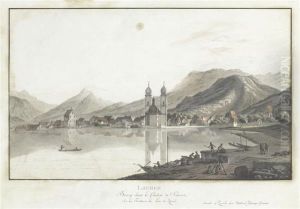Matthias Pfenninger Paintings
Matthias Pfenninger was a Swiss artist, born in 1739 in Zürich, Switzerland. His life and work are situated within the context of the 18th century, a period that witnessed significant transformations in the arts across Europe, including the emergence of Rococo and the early stages of Neoclassicism. Pfenninger's artistic contributions, though not as widely recognized as some of his contemporaries, provide insight into the Swiss art scene of this era and its connections to broader European art movements.
Pfenninger showed an early aptitude for drawing and painting, which led him to pursue formal training. His style was influenced by the Rococo movement, known for its elaborate ornamentation, intricate details, and light, pastel colors. However, Pfenninger also incorporated elements that anticipated the simplicity and classical references of Neoclassicism. This blend of influences is evident in his works, which often feature pastoral scenes, religious subjects, and portraits. His ability to capture the nuances of light and shadow, combined with a delicate use of color, distinguished his paintings and drawings.
Throughout his career, Pfenninger contributed to the cultural life of Zürich and beyond. He worked as a painter, illustrator, and occasionally as an art teacher, sharing his knowledge and skills with the next generation of Swiss artists. His works were exhibited in local galleries and found their way into the collections of Swiss art lovers. Despite the limited reach of his fame, Pfenninger's dedication to his craft and his role in the local art community were significant. He was part of a network of artists and intellectuals that fostered artistic exchange and innovation in Switzerland.
Pfenninger's legacy is that of a skilled artist who navigated the changing tastes and styles of the 18th century with grace and adaptability. His contributions to Swiss art, particularly in Zürich, reflect the broader trends in European art while also showcasing the unique cultural and aesthetic sensibilities of his homeland. Matthias Pfenninger passed away in 1813, leaving behind a body of work that, though not as widely celebrated as that of some of his peers, remains an important part of the Swiss artistic heritage.
